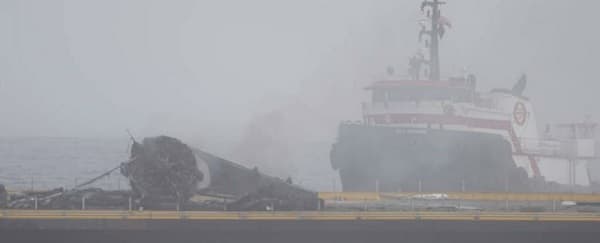SpaceX Rocket Falcon 9 Crash Lands Again - Motto of Reusability Questionable
After a successful launch of the Jason-3 satellite into orbit at the Vandenberg Air Force Base in California, SpaceX’s attempt to land the Falcon 9 rocket back on a drone ship failed, and its motto of space reusability remains questionable.
Jason-3 is a US-European mission, in which the National Oceanic and Atmospheric Administration (NOAA) partners with the CNES, the EUMETSAT and NASA. It is a long term prospect focusing on tracking rise sea levels owing to climate change. It is also designed to facilitate better forecasting through sensitive ocean information- hurricane intensities, weather patterns etc.

The crash landing of the Falcon rocket did not stun many. A SpaceX spokesperson seemed to have reasonable justification; he claims that the target area was spot-on, but the landing was slightly harder which might have caused one of the landing legs to break on touch down. That makes sense when you’re talking about a structure that is 68.4 metres tall, 3.66 metres in diameter, and a bit too heavy to even keep account.
SpaceX has had a long history of successes, and yet failures do not remain unseen. Ever since it launched Falcon 1, the first privately funded liquid-fuelled rocket, in September 2008, there has been no looking back. The Falcon 9 enabled <a href="https://www.crazyengineers.com/threads/spacex-creates-history-launched-for-the-iss.65752">SpaceX Creates History: Launched For The ISS!</a> to the International Space Station was a path-breaking achievement in all respects. In December last year, history was created with the first ever orbital rocket landing. However, when it comes to at-sea landing, SpaceX stands at zero out of three, with two of the failed attempts coming last year, and this one completing the list. Certainly, it has been a busy couple of years for Elon Musk and his team.
He confirms that SpaceX will continue focusing on drone ship landings, as opposed to landing on the ground. According to him, it is physically impossible to land on the launch site for speeds greater than 6000 km/hr; with a ship, there is no need to zero out the lateral velocity so speeds in the range of 9000 km/hr are allowed.
Take a look at a video that depicts the failure, Musk himself uploaded it in his Instagram:
Source: #-Link-Snipped-#
Jason-3 is a US-European mission, in which the National Oceanic and Atmospheric Administration (NOAA) partners with the CNES, the EUMETSAT and NASA. It is a long term prospect focusing on tracking rise sea levels owing to climate change. It is also designed to facilitate better forecasting through sensitive ocean information- hurricane intensities, weather patterns etc.

The crash landing of the Falcon rocket did not stun many. A SpaceX spokesperson seemed to have reasonable justification; he claims that the target area was spot-on, but the landing was slightly harder which might have caused one of the landing legs to break on touch down. That makes sense when you’re talking about a structure that is 68.4 metres tall, 3.66 metres in diameter, and a bit too heavy to even keep account.
SpaceX has had a long history of successes, and yet failures do not remain unseen. Ever since it launched Falcon 1, the first privately funded liquid-fuelled rocket, in September 2008, there has been no looking back. The Falcon 9 enabled <a href="https://www.crazyengineers.com/threads/spacex-creates-history-launched-for-the-iss.65752">SpaceX Creates History: Launched For The ISS!</a> to the International Space Station was a path-breaking achievement in all respects. In December last year, history was created with the first ever orbital rocket landing. However, when it comes to at-sea landing, SpaceX stands at zero out of three, with two of the failed attempts coming last year, and this one completing the list. Certainly, it has been a busy couple of years for Elon Musk and his team.
He confirms that SpaceX will continue focusing on drone ship landings, as opposed to landing on the ground. According to him, it is physically impossible to land on the launch site for speeds greater than 6000 km/hr; with a ship, there is no need to zero out the lateral velocity so speeds in the range of 9000 km/hr are allowed.
Take a look at a video that depicts the failure, Musk himself uploaded it in his Instagram:
0
